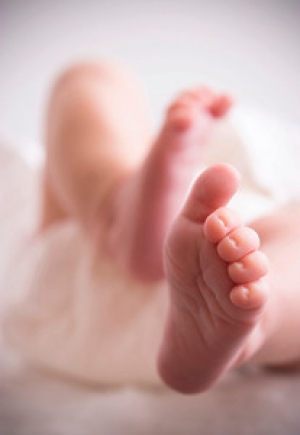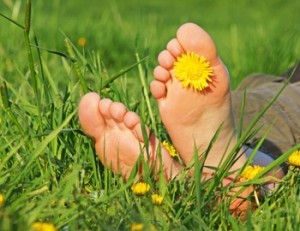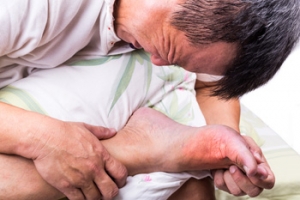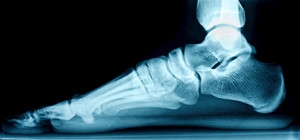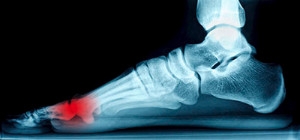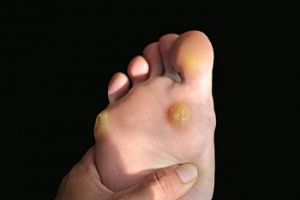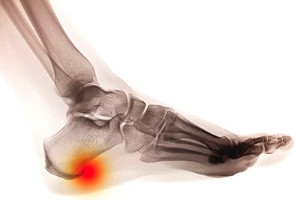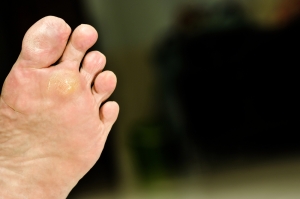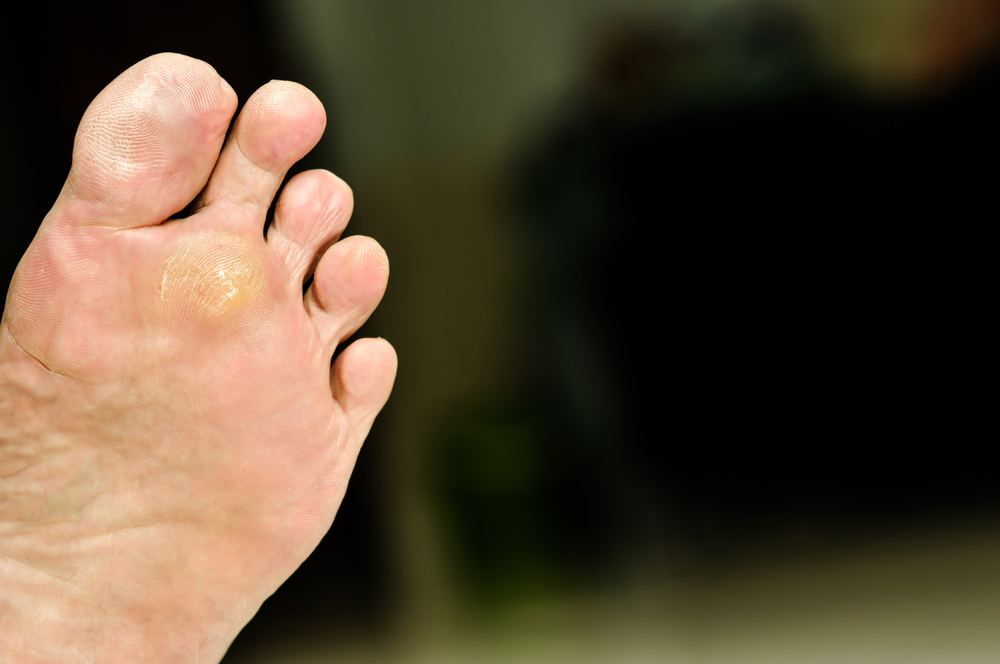Richfield (435) 896-6497
Ephraim (435) 283-4076
Super User
Is Clubfoot Considered Curable?
Clubfoot is a congenital disorder in which a child’s foot (or feet) twist down and inward, due to tight Achilles tendons and calf muscles. This condition is said to affect nearly 200,000 newborns annually. Although there is no known cause, research points to infants being more predisposed to clubfoot if a family member or parent was previously affected. Clubfoot is considered by many to be curable if diagnosed early enough and treated properly. There are various techniques to reposition the child’s feet including casting, taping, bracing, or surgery in advanced cases. If you believe your child may have clubfoot, contact a podiatrist for a thorough examination and to discuss treatment options.
Making sure that your children maintain good foot health is very important as they grow. If you have any questions, contact Dr. Blake Zobell of Utah. Our doctor can provide the care you need to keep you pain-free and on your feet.
Keeping Children's Feet Healthy
Having healthy feet during childhood can help prevent medical problems later in life, namely in the back and legs. As children grow, their feet require different types of care. Here are some things to consider...
Although babies do not walk yet, it is still very important to take care of their feet.
Avoid putting tight shoes or socks on his or her feet.
Allow the baby to stretch and kick his or her feet to feel comfortable.
As a toddler, kids are now on the move and begin to develop differently. At this age, toddlers are getting a feel for walking, so don’t be alarmed if your toddler is unsteady or ‘walks funny’.
As your child gets older, it is important to teach them how to take care of their feet.
Show them proper hygiene to prevent infections such as fungus.
Be watchful for any pain or injury.
Have all injuries checked by a doctor as soon as possible.
Comfortable, protective shoes should always be worn, especially at play.
If you have any questions please feel free to contact one of our offices located in Richfield and Ephraim, Utah . We offer the newest diagnostic and treatment technologies for all your foot and ankle needs.
What Is Hyperhidrosis of the Feet?
 The medical term for excessively sweaty feet is plantar hyperhidrosis. Sweating usually occurs as a cooling mechanism in response to physical activity or stress, but hyperhidrosis occurs when sweating isn't necessary. This sweating is excessive, which can understandably be uncomfortable and embarrassing. Common treatments for plantar hyperhidrosis can include antiperspirant prescriptions, botox injections, iontophoresis, and other medications. If you are struggling with excessively sweaty feet, it is recommended that you consult with a podiatrist for the treatment that is best for you.
The medical term for excessively sweaty feet is plantar hyperhidrosis. Sweating usually occurs as a cooling mechanism in response to physical activity or stress, but hyperhidrosis occurs when sweating isn't necessary. This sweating is excessive, which can understandably be uncomfortable and embarrassing. Common treatments for plantar hyperhidrosis can include antiperspirant prescriptions, botox injections, iontophoresis, and other medications. If you are struggling with excessively sweaty feet, it is recommended that you consult with a podiatrist for the treatment that is best for you.
If you are suffering from hyperhidrosis contact Dr. Blake Zobell of Utah. Our doctor can provide the care you need to attend to all of your foot and ankle needs.
Hyperhidrosis of the Feet
Hyperhidrosis is a rare disorder that can cause people to have excessive sweating of their feet. This can usually occur all on its own without rigorous activity involved. People who suffer from hyperhidrosis may also experience sweaty palms.
Although it is said that sweating is a healthy process meant to cool down the body temperature and to maintain a proper internal temperature, hyperhidrosis may prove to be a huge hindrance on a person’s everyday life.
Plantar hyperhidrosis is considered to be the main form of hyperhidrosis. Secondary hyperhidrosis can refer to sweating that occurs in areas other than the feet or hands and armpits. Often this may be a sign of it being related to another medical condition such as menopause, hyperthyroidism and even Parkinson’s disease.
In order to alleviate this condition, it is important to see your doctor so that they may prescribe the necessary medications so that you can begin to live a normal life again. If this is left untreated, it is said that it will persist throughout an individual’s life.
A last resort approach would be surgery, but it is best to speak with your doctor to find out what may be the best treatment for you.
If you have any questions please feel free to contact one of our offices located in Richfield and Ephraim, Utah . We offer the newest diagnostic and treatment technologies for all your foot and ankle needs.
Gout Can Affect the Joints in the Big Toe
 A type of arthritis that is referred to as gout is considered to be common among men over the age of forty. It generally occurs from an increased level of uric acid in the blood, which can happen for a variety of reasons. These can consist of genetic factors, underlying medical conditions, or from eating foods that have large amounts of purines. These specific types of foods often include red meat, shellfish, and drinks that have a high sugar content. The symptoms that are associated with gout are severe pain and discomfort in the joints of the big toe, swelling, and extreme tenderness. Some patients can experience pain that is so debilitating, it can hinder their ability to walk. When treating gout, it may be beneficial to implement healthy eating habits into your daily routine, and taking anti-inflammatory medication may relieve pain. If you have gout, it is suggested that you are under the care of a podiatrist who can help you to manage this condition.
A type of arthritis that is referred to as gout is considered to be common among men over the age of forty. It generally occurs from an increased level of uric acid in the blood, which can happen for a variety of reasons. These can consist of genetic factors, underlying medical conditions, or from eating foods that have large amounts of purines. These specific types of foods often include red meat, shellfish, and drinks that have a high sugar content. The symptoms that are associated with gout are severe pain and discomfort in the joints of the big toe, swelling, and extreme tenderness. Some patients can experience pain that is so debilitating, it can hinder their ability to walk. When treating gout, it may be beneficial to implement healthy eating habits into your daily routine, and taking anti-inflammatory medication may relieve pain. If you have gout, it is suggested that you are under the care of a podiatrist who can help you to manage this condition.
Gout is a painful condition that can be treated. If you are seeking treatment, contact Dr. Blake Zobell from Utah. Our doctor will treat your foot and ankle needs.
What Is Gout?
Gout is a form of arthritis that is characterized by sudden, severe attacks of pain, redness, and tenderness in the joints. The condition usually affects the joint at the base of the big toe. A gout attack can occur at any random time, such as the middle of the night while you are asleep.
Symptoms
- Intense Joint Pain - Usually around the large joint of your big toe, and it most severe within the first four to twelve hours
- Lingering Discomfort - Joint discomfort may last from a few days to a few weeks
- Inflammation and Redness -Affected joints may become swollen, tender, warm and red
- Limited Range of Motion - May experience a decrease in joint mobility
Risk Factors
- Genetics - If family members have gout, you’re more likely to have it
- Medications - Diuretic medications can raise uric acid levels
- Gender/Age - Gout is more common in men until the age of 60. It is believed that estrogen protects women until that point
- Diet - Eating red meat and shellfish increases your risk
- Alcohol - Having more than two alcoholic drinks per day increases your risk
- Obesity - Obese people are at a higher risk for gout
Prior to visiting your podiatrist to receive treatment for gout, there are a few things you should do beforehand. If you have gout you should write down your symptoms--including when they started and how often you experience them, important medical information you may have, and any questions you may have. Writing down these three things will help your podiatrist in assessing your specific situation so that he or she may provide the best route of treatment for you.
If you have any questions, please feel free to contact one of our offices located in Richfield and Ephraim, Utah . We offer the newest diagnostic and treatment technologies for all your foot care needs.
Exercises for Flat Feet
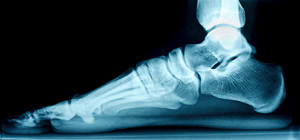 Flat feet is a foot condition that is often recognized as fallen arches. Those affected with this condition will have feet in which their soles lay completely flat on the ground. Arch supports, as well as performing certain exercises, may help to reduce the pain that may coincide with having flat feet. There are a number of different exercises you can practice to help with your flat feet, one of them being arch lifts. To perform this exercise, stand on the floor with your back straight. Then, slowly begin to lift the outer edges of your feet, with your toes remaining on the floor. Continue to practice a couple of repetitions for about 15 minutes. Calf stretches are another helpful exercise for flat feet. Again, stand on the floor with you back straight, then begin to slowly lift your heels, bringing them up and down, not allowing the heels to hit the floor. Lastly, roll stretches can be performed by sitting in a chair and rolling a foam roller, ice-cold can, or water bottle back and forth with the bottom of your foot. For additional recommendations and more exercises for treating flat feet, it’s suggested you consult with your local podiatrist.
Flat feet is a foot condition that is often recognized as fallen arches. Those affected with this condition will have feet in which their soles lay completely flat on the ground. Arch supports, as well as performing certain exercises, may help to reduce the pain that may coincide with having flat feet. There are a number of different exercises you can practice to help with your flat feet, one of them being arch lifts. To perform this exercise, stand on the floor with your back straight. Then, slowly begin to lift the outer edges of your feet, with your toes remaining on the floor. Continue to practice a couple of repetitions for about 15 minutes. Calf stretches are another helpful exercise for flat feet. Again, stand on the floor with you back straight, then begin to slowly lift your heels, bringing them up and down, not allowing the heels to hit the floor. Lastly, roll stretches can be performed by sitting in a chair and rolling a foam roller, ice-cold can, or water bottle back and forth with the bottom of your foot. For additional recommendations and more exercises for treating flat feet, it’s suggested you consult with your local podiatrist.
Flatfoot is a condition many people suffer from. If you have flat feet, contact Dr. Blake Zobell from Utah. Our doctor will treat your foot and ankle needs.
What Are Flat Feet?
Flatfoot is a condition in which the arch of the foot is depressed and the sole of the foot is almost completely in contact with the ground. About 20-30% of the population generally has flat feet because their arches never formed during growth.
Conditions & Problems:
Having flat feet makes it difficult to run or walk because of the stress placed on the ankles.
Alignment – The general alignment of your legs can be disrupted, because the ankles move inward which can cause major discomfort.
Knees – If you have complications with your knees, flat feet can be a contributor to arthritis in that area.
Symptoms
- Pain around the heel or arch area
- Trouble standing on the tip toe
- Swelling around the inside of the ankle
- Flat look to one or both feet
- Having your shoes feel uneven when worn
Treatment
If you are experiencing pain and stress on the foot you may weaken the posterior tibial tendon, which runs around the inside of the ankle.
If you have any questions please feel free to contact one of our offices located in Richfield and Ephraim, Utah . We offer the newest diagnostic and treatment technologies for all your foot and ankle needs.
Signs You May Have Developed Sesamoiditis
 Sesamoiditis may occur when the sesamoid bones in the feet become inflamed. This condition can be incredibly uncomfortable and can cause pain that is typically felt in the ball of the foot. This condition is common among dancers, joggers, those who frequently wear high heels, as well as those who have high-arched feet. Along with feeling pain towards the forefront of the affected foot, you may also notice swelling and redness around the affected area. Custom orthotics can be worn as a means to alleviate pain and reduce pressure. For a proper diagnosis and treatment options, it is suggested that you contact a podiatrist if you feel that you are afflicted with sesamoiditis.
Sesamoiditis may occur when the sesamoid bones in the feet become inflamed. This condition can be incredibly uncomfortable and can cause pain that is typically felt in the ball of the foot. This condition is common among dancers, joggers, those who frequently wear high heels, as well as those who have high-arched feet. Along with feeling pain towards the forefront of the affected foot, you may also notice swelling and redness around the affected area. Custom orthotics can be worn as a means to alleviate pain and reduce pressure. For a proper diagnosis and treatment options, it is suggested that you contact a podiatrist if you feel that you are afflicted with sesamoiditis.
Sesamoiditis is an unpleasant foot condition characterized by pain in the balls of the feet. If you think you’re struggling with sesamoiditis, contact Dr. Blake Zobell of Utah. Our doctor will treat your condition thoroughly and effectively.
Sesamoiditis
Sesamoiditis is a condition of the foot that affects the ball of the foot. It is more common in younger people than it is in older people. It can also occur with people who have begun a new exercise program, since their bodies are adjusting to the new physical regimen. Pain may also be caused by the inflammation of tendons surrounding the bones. It is important to seek treatment in its early stages because if you ignore the pain, this condition can lead to more serious problems such as severe irritation and bone fractures.
Causes of Sesamoiditis
- Sudden increase in activity
- Increase in physically strenuous movement without a proper warm up or build up
- Foot structure: those who have smaller, bonier feet or those with a high arch may be more susceptible
Treatment for sesamoiditis is non-invasive and simple. Doctors may recommend a strict rest period where the patient forgoes most physical activity. This will help give the patient time to heal their feet through limited activity. For serious cases, it is best to speak with your doctor to determine a treatment option that will help your specific needs.
If you have any questions please feel free to contact one of our offices located in Richfield and Ephraim, Utah . We offer the newest diagnostic and treatment technologies for all your foot and ankle needs.
Read more about SesamoiditisWhat Causes Corns?
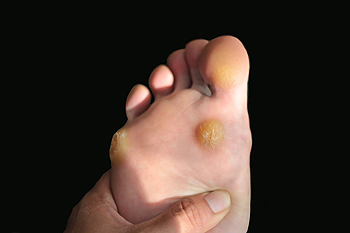 Patients who have experienced corns on their toes are often aware of the pain and discomfort they may cause. A corn is defined as a portion of skin that has thickened as a result of excess friction. This can happen when shoes that are worn do not fit correctly. Common places for a corn to develop can be on the inside or top of the toes, in addition to the bottom of the feet. Some patients find moderate relief when the foot is soaked in warm water, followed by using a pumice stone to gently remove the corn. For severe or stubborn corns, it is suggested that you seek the counsel of a podiatrist who can guide you toward the correct treatment options.
Patients who have experienced corns on their toes are often aware of the pain and discomfort they may cause. A corn is defined as a portion of skin that has thickened as a result of excess friction. This can happen when shoes that are worn do not fit correctly. Common places for a corn to develop can be on the inside or top of the toes, in addition to the bottom of the feet. Some patients find moderate relief when the foot is soaked in warm water, followed by using a pumice stone to gently remove the corn. For severe or stubborn corns, it is suggested that you seek the counsel of a podiatrist who can guide you toward the correct treatment options.
If you have any concerns regarding your feet and ankles, contact Dr. Blake Zobell of Utah. Our doctor will treat your foot and ankle needs.
Corns: What Are They? and How Do You Get Rid of Them?
Corns can be described as areas of the skin that have thickened to the point of becoming painful or irritating. They are often layers and layers of the skin that have become dry and rough, and are normally smaller than calluses.
Ways to Prevent Corns
There are many ways to get rid of painful corns such as wearing:
- Well-fitting socks
- Comfortable shoes that are not tight around your foot
- Shoes that offer support
Treating Corns
Treatment of corns involves removing the dead skin that has built up in the specific area of the foot. Consult with Our doctor to determine the best treatment option for your case of corns.
If you have any questions please feel free to contact one of our offices located in Richfield and Ephraim, Utah . We offer the newest diagnostic and treatment technologies for all your foot and ankle needs.
Everything You Need to Know About Corns
Corns are hard and thick areas of skin that form as a result of constant rubbing, friction, or pressure on the skin. They are patches of dead skin with a small plug toward the center. They may appear on the tops and sides of toes and can make walking painful.
Soft corns are typically thinner with a white color and rubbery texture. Soft corns tend to appear between the toes. Seed corns are another type of corn that appear in clusters and can be tender if they are on a weight-bearing part of the foot. Seed corns usually appear on the bottom of the foot and are likely caused by a blockage in sweat ducts.
While corns and calluses are somewhat similar, calluses are a bit different. Calluses are a patch of dead skin that can occur anywhere on the body. In comparison to corns, calluses are usually a bit larger in size. However, both corns and calluses are caused by increased friction on the skin.
There are some risk factors that may increase your chances of developing corns and calluses. If you have bunions, hammertoe, or a bone spur, you are more likely to develop a corn or callus on your foot.
While Corns and Calluses tend to disappear when the friction to the affected area ceases, the help of a podiatrist may be useful in the removal process. It is important to remove the dead skin around the area and this may be done in a few different ways. Moisturizing creams may be helpful in softening and removing the dead skin around the callus. You should never use razors or other pedicure equipment to remove your corns. Doing this may worsen your corn or callus and cause infection.
In some cases, corns and calluses may be caused by abnormal foot structure or walking motion. In such a case, you should seek a podiatrist’s assistance in order to correct the issue.
Possible Causes and Symptoms of Heel Spurs
Pain in the heel and surrounding area may be indicative of a heel spur. It is considered to be a bony growth that develops on the heel of the foot. It can grow in length, and extend to the middle of the foot, which may cause severe pain and discomfort. The symptoms that many patients experience typically consist of a sharp pain in the heel after arising in the morning, heat coming from the affected area, and the heel may be extremely tender, which may inhibit walking. This condition can occur as a patient ages, which may also contribute to the soft tissue becoming thinner in the heel. It may happen as a result of an injury that previously occurred to the heel, wearing shoes that do not fit correctly, or it may develop from being overweight. If you are afflicted with a heel spur, it is strongly suggested that you are under the care of a podiatrist who can properly treat this condition.
Heel spurs can be incredibly painful and sometimes may make you unable to participate in physical activities. To get medical care for your heel spurs, contact Dr. Blake Zobell from Utah. Our doctor will do everything possible to treat your condition.
Heels Spurs
Heel spurs are formed by calcium deposits on the back of the foot where the heel is. This can also be caused by small fragments of bone breaking off one section of the foot, attaching onto the back of the foot. Heel spurs can also be bone growth on the back of the foot and may grow in the direction of the arch of the foot.
Older individuals usually suffer from heel spurs and pain sometimes intensifies with age. One of the main condition's spurs are related to is plantar fasciitis.
Pain
The pain associated with spurs is often because of weight placed on the feet. When someone is walking, their entire weight is concentrated on the feet. Bone spurs then have the tendency to affect other bones and tissues around the foot. As the pain continues, the feet will become tender and sensitive over time.
Treatments
There are many ways to treat heel spurs. If one is suffering from heel spurs in conjunction with pain, there are several methods for healing. Medication, surgery, and herbal care are some options.
If you have any questions feel free to contact one of our offices located in Richfield and Ephraim, Utah . We offer the latest in diagnostic and treatment technology to meet your needs.
Heel Spurs
Heel spurs are the result of calcium deposits that cause bony protrusions on the underside of the heel. Heel spurs are usually painless, but they have the potential to cause heel pain. Heel spurs tend to be associated with plantar fasciitis, which is a condition that causes inflammation of the band of connective tissue that runs along the bottom of the foot. They most often occur to athletes whose sports involve a lot of running and jumping.
Some risk factors for developing heel spurs include running and jogging on hard surfaces, being obese, wearing poorly fitting shoes, or having walking gait abnormalities.
It is possible to have a heel spur without showing signs of any symptoms. However, if inflammation develops at the point of the spur’s formation, you may have pain while walking or running. In terms of diagnosis, sometimes all a doctor needs to know is that the patient is experiencing a sharp pain localized to the heel to diagnose a heel spur. Other times, an x-ray may be needed to confirm the presence of a heel spur.
Heel spurs can be prevented by wearing well-fitting shoes that have shock-absorbent soles. You should also be sure that you are choosing the right shoe for the activity you want to partake in; for example, do not wear walking shoes when you want to go on a run. Additionally, maintaining a healthy weight can be beneficial toward preventing heel spurs, as it will prevent an excess amount of pressure being placed on the ligaments.
There are a variety of treatment options for people with heel spurs. Some of these include stretching exercises, physical therapy, shoe inserts, or taping and strapping to rest stressed muscles and tendons. If you have heel pain that lasts longer than a month, don’t hesitate to seek help from a podiatrist. Your doctor can help you determine which treatment option is best for you.
Where Does a Plantar Wart Develop?
A plantar wart develops on the bottom of the foot, and is generally in the heel area. It grows into the heel as a result of pressure that is put on the foot as everyday activities are completed. The medical term for this type of wart is known as a verrucae wart, and it is caused by the human papillomavirus (HPV). This type of virus attacks the bottom of the feet, and can cause severe pain and discomfort. A common symptom of a plantar wart can include pain and tenderness while walking, and it may be more noticeable in the morning upon arising. There are a variety of ways to treat this type of wart. These can range from laser therapy, applying salicylic acid cream to the affected area, or possibly using essential oils. If you are afflicted with a plantar wart, it is strongly advised that you seek the counsel of a podiatrist who can guide you toward the proper treatment.
Plantar warts can be very uncomfortable. If you need your feet checked, contact Dr. Blake Zobell from Utah. Our doctor will assist you with all of your foot and ankle needs.
About Plantar Warts
Plantar warts are the result of HPV, or human papillomavirus, getting into open wounds on the feet. They are mostly found on the heels or balls of the feet.
While plantar warts are generally harmless, those experiencing excessive pain or those suffering from diabetes or a compromised immune system require immediate medical care. Plantar warts are easily diagnosed, usually through scraping off a bit of rough skin or by getting a biopsy.
Symptoms
- Lesions on the bottom of your feet, usually rough and grainy
- Hard or thick callused spots
- Wart seeds, which are small clotted blood vessels that look like little black spots
- Pain, discomfort, or tenderness of your feet when walking or standing
Treatment
- Freezing
- Electric tool removal
- Laser Treatment
- Topical Creams (prescription only)
- Over-the-counter medications
To help prevent developing plantar warts, avoid walking barefoot over abrasive surfaces that can cause cuts or wounds for HPV to get into. Avoiding direct contact with other warts, as well as not picking or rubbing existing warts, can help prevent the further spread of plantar warts. However, if you think you have developed plantar warts, speak to your podiatrist. He or she can diagnose the warts on your feet and recommend the appropriate treatment options.
If you have any questions please feel free to contact one of our offices located in Richfield and Ephraim, Utah . We offer the newest diagnostic and treatment technologies for all your foot and ankle needs.





